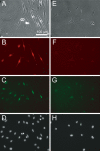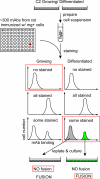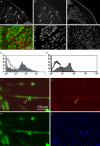Generation of a monoclonal antibody reactive to prefusion myocytes
- PMID: 21597958
- PMCID: PMC3141826
- DOI: 10.1007/s10974-011-9247-8
Generation of a monoclonal antibody reactive to prefusion myocytes
Abstract
We established a novel monoclonal antibody, Yaksa that is specific to a subpopulation of myogenic cells. The Yaksa antigen is not expressed on the surface of growing myoblasts but only on a subpopulation of myogenin-positive myocytes. When Yaksa antigen-positive mononucleated cells were freshly prepared from a murine myogenic cell by a cell sorter, they fused with each other and formed multinucleated myotubes shortly after replating while Yaksa antigen-negative cells scarcely generated myotubes. These results suggest that Yaksa could segregate fusion-competent, mononucleated cells from fusion-incompetent cells during muscle differentiation. The Yaksa antigen was also expressed in developing muscle and regenerating muscle in vivo and it was localized at sites of cell-cell contact between mono-nucleated muscle cells and between mono-nucleated muscle cells and myotubes. Thus, Yaksa that marks prefusion myocytes before myotube formation can be a useful tool to elucidate the cellular and molecular mechanisms of myogenic cell fusion.
Figures




Similar articles
-
Localized cyclic AMP-dependent protein kinase activity is required for myogenic cell fusion.Exp Cell Res. 2008 Jan 15;314(2):387-97. doi: 10.1016/j.yexcr.2007.10.006. Epub 2007 Oct 17. Exp Cell Res. 2008. PMID: 18001711
-
Myogenic programs of mouse muscle cell lines: expression of myosin heavy chain isoforms, MyoD1, and myogenin.J Cell Biol. 1990 Sep;111(3):1149-59. doi: 10.1083/jcb.111.3.1149. J Cell Biol. 1990. PMID: 2167895 Free PMC article.
-
Expression of a developmentally regulated antigen on the surface of skeletal and cardiac muscle cells.J Cell Biol. 1985 Jun;100(6):1977-87. doi: 10.1083/jcb.100.6.1977. J Cell Biol. 1985. PMID: 3889014 Free PMC article.
-
Preparation of a monoclonal antibody and expression of its antigen associated with myogenic differentiation on spontaneous and artificial myotubes derived from avian myoblasts.Cell Struct Funct. 1993 Oct;18(5):285-96. doi: 10.1247/csf.18.285. Cell Struct Funct. 1993. PMID: 7513264
-
Di-(2-ethylhexyl)-phthalate reduces MyoD and myogenin expression and inhibits myogenic differentiation in C2C12 cells.J Toxicol Sci. 2013;38(5):783-91. doi: 10.2131/jts.38.783. J Toxicol Sci. 2013. PMID: 24067726

